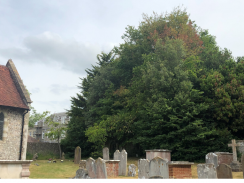Thousands of endangered elms are at risk after the recent hot spring weather, according to Brighton and Hove City Council.
The warm conditions appear to have encouraged the renewed spread of elm disease – also known as Dutch elm disease.
Now council environment chiefs are asking the public to help protect our elms by reporting any trees showing signs of disease.
Brighton and Hove is one of a relatively few places left in England with a significant number of elms after disease threatened to eradicate the species.
The council urged people “to help tackle a higher than normal outbreak of elm disease”, adding: “The infection, which could wipe out thousands of our historic elms if not brought under control, has already started killing off previously healthy trees throughout the city.
“Our tree experts say the disease, brought on this year by the recent hot weather, is beginning to spread through many of the city’s 17,000 elms.”
Councillor Anne Pissaridou, who chairs the council’s Environment, Transport and Sustainability Committee, said: “Elm disease is fairly easy to spot if you know the signs and what to look for.
“We’re asking you to become an extra pair of eyes and help flag up any trees – on both public and private land – you believe may be infected.
“We can then take immediate action to inspect the tree, and if infected, remove it and stop the disease spreading.
“Your swift action could help save the lives of many of our elm trees.”
How to tell if a tree is diseased
- Symptoms start to show in early June and the disease season lasts until September
- Early infection signs are a wilting and browning / yellowing of parts of the foliage, or greenery, anywhere on the tree
- An elm tree losing its leaves (thinning foliage) in early summer while other elms around it are still full and healthy looking
…
How Elm disease starts
- Fungi is transferred from diseased to healthy elms by elm bark beetles
- The disease is also transferred underground between trees through the roots
- New trees grow from infected fragments after the removal of a diseased tree
…
The council added: “Residents can also help by not buying elm logs for fuel or any garden ornaments or seating made of elm which may already be infected by the bark beetles.
“If you suspect an Elm tree is diseased, please email ElmDisease@brighton-hove.gov.uk, ideally with a photograph of the tree, a close up of the symptoms and a location including street name, building, house number/name or park with approximate location.”









